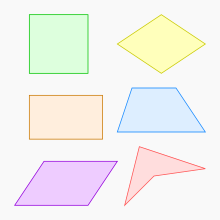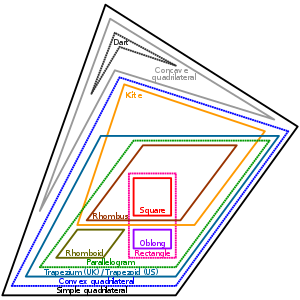This article is about four-sided mathematical shapes. For other uses, see Quadrilateral (disambiguation).
| Quadrilateral | |
|---|---|
 Six different types of quadrilaterals | |
| Edges and vertices | 4 |
| Schläfli symbol | {4} (for square) |
| Area | various methods; see below |
| Internal angle (degrees) | 90° (for square) |
In Euclidean plane geometry, a quadrilateral is a polygon with four sides (or edges) and four vertices or corners. Sometimes, the term quadrangleis used, by analogy with triangle, and sometimes tetragon for consistency with pentagon (5-sided), hexagon (6-sided) and so on.
The origin of the word "quadrilateral" is the two Latin words quadri, a variant of four, and latus, meaning "side."
Quadrilaterals are simple (not self-intersecting) or complex (self-intersecting), also called crossed. Simple quadrilaterals are either convex orconcave.
The interior angles of a simple (and planar) quadrilateral ABCD add up to 360 degrees of arc, that is
This is a special case of the n-gon interior angle sum formula (n − 2) × 180°. In a crossed quadrilateral, the interior angles on either side of the crossing add up to 720°.[1]
All convex quadrilaterals tile the plane by repeated rotation around the midpoints of their edges.
Convex quadrilaterals – parallelograms
A parallelogram is a quadrilateral with two pairs of parallel sides. Equivalent conditions are that opposite sides are of equal length; that opposite angles are equal; or that the diagonals bisect each other. Parallelograms also include the square, rectangle, rhombus and rhomboid.
- Rhombus or rhomb: all four sides are of equal length. Equivalent conditions are that opposite sides are parallel and opposite angles are equal, or that the diagonals perpendicularly bisect each other. An informal description is "a pushed-over square" (including a square).
- Rhomboid: a parallelogram in which adjacent sides are of unequal lengths and angles are oblique (not right angles). Informally: "a pushed-over rectangle with no right angles."
- Rectangle: all four angles are right angles. An equivalent condition is that the diagonals bisect each other and are equal in length. Informally: "a box or oblong" (including a square).
- Square (regular quadrilateral): all four sides are of equal length (equilateral), and all four angles are right angles. An equivalent condition is that opposite sides are parallel (a square is a parallelogram), that the diagonals perpendicularly bisect each other, and are of equal length. A quadrilateral is a square if and only if it is both a rhombus and a rectangle (four equal sides and four equal angles).
- Oblong: a term sometimes used to denote a rectangle which has unequal adjacent sides (i.e. a rectangle that is not a square).
[edit]Convex quadrilaterals – other
- Kite: two pairs of adjacent sides are of equal length. This implies that one diagonal divides the kite into congruent triangles, and so the angles between the two pairs of equal sides are equal in measure. It also implies that the diagonals are perpendicular.
- Right kite: a kite with two opposite right angles.
- Trapezoid (North American English) or Trapezium (British English): at least one pair of opposite sides are parallel.
- Trapezium (NAm.): no sides are parallel. (In British English this would be called an irregular quadrilateral, and was once called a trapezoid.)
- Isosceles trapezoid (NAm.) or isosceles trapezium (Brit.): one pair of opposite sides are parallel and the other two sides are of equal length. This implies that the base angles are equal in measure, and that the diagonals are of equal length. An alternative definition is a quadrilateral with an axis of symmetry bisecting one pair of opposite sides.
- Tangential trapezoid: a trapezoid where the four sides are tangents to an inscribed circle.
- Tangential quadrilateral: the four sides are tangents to an inscribed circle. A convex quadrilateral is tangential if and only if opposite sides have equal sums.
- Cyclic quadrilateral: the four vertices lie on a circumscribed circle. A convex quadrilateral is cyclic if and only if opposite angles sum to 180°.
- Bicentric quadrilateral: it is both tangential and cyclic.
- Orthodiagonal quadrilateral: the diagonals cross at right angles.
- Equidiagonal quadrilateral: the diagonals are of equal length.
- Ex-tangential quadrilateral: the four extensions of the sides are tangent to an excircle.
[edit]More quadrilaterals
- An equilic quadrilateral has two opposite equal sides that, when extended, meet at 60°.
- A Watt quadrilateral is a quadrilateral with a pair of opposite sides of equal length.[2]
- A quadric quadrilateral is a convex quadrilateral whose four vertices all lie on the perimeter of a square.[3]
- A geometric chevron (dart or arrowhead) is a concave quadrilateral with bilateral symmetry like a kite, but one interior angle is reflex.
- A self-intersecting quadrilateral is called variously a cross-quadrilateral, crossed quadrilateral, butterfly quadrilateral or bow-tie quadrilateral. A special case of crossed quadrilaterals are the antiparallelograms, crossed quadrilaterals in which (like a parallelogram) each pair of nonadjacent sides has equal length. The diagonals of a crossed or concave quadrilateral do not intersect inside the shape.
- A non-planar quadrilateral is called a skew quadrilateral. Formulas to compute its dihedral angles from the edge lengths and the angle between two adjacent edges were derived for work on the properties of molecules such as cyclobutane that contain a "puckered" ring of four atoms.[4] See skew polygon for more. Historically the term gauche quadrilateral was also used to mean a skew quadrilateral.[5] A skew quadrilateral together with its diagonals form a (possibly non-regular) tetrahedron, and conversely every skew quadrilateral comes from a tetrahedron where a pair of opposite edges is removed.



No comments:
Post a Comment